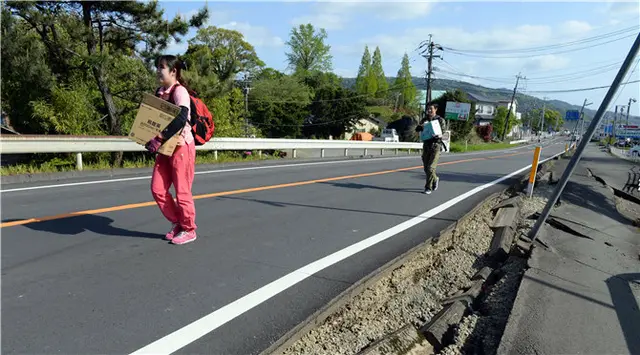People here said they had known that a network of fault lines ran under their town like veins. But no major earthquake had struck in anyone’s lifetime. Even in Japan, the most seismically unstable country in the world, that fact had apparently created a false sense of security.
That was before two earthquakes struck within just over a day last week.
On Sunday, some braved the seemingly endless aftershocks to sift through their shattered homes, looking for valuables--a bankbook, medication needed by an elderly relative. Others sheltered in their cars, as even the sturdiest buildings suddenly felt fragile.
“There were stories from hundreds of years ago, but nobody thought it would happen right under them,” said Tadashi Uchida, 77, the head of a neighborhood association in a section of Mashiki with about 500 households.
Dozens of the area’s mostly wooden homes, including Uchida’s, crumbled in the twin quakes, which struck late Thursday and early Saturday. With magnitudes of 6.2 and 7, according to the U.S. Geological Survey, they left at least 42 people dead.
Water, electricity and gas remained cut off in most of Mashiki and surrounding towns and villages on the island of Kyushu, in Japan’s far southwest. More than 100,000 people were in temporary shelters, the authorities said.
Uchida has been sleeping in his small hatchback, together with his wife and an ailing 82-year-old neighbor. The car sat on Sunday alongside about 20 others in a local park, where the ground was split by a long gash several feet wide and several feet deep.
At a cluster of picnic tables at one end of the park, several women in their 70s and 80s cooked rice on camp stoves, laughing to buoy their spirits. They were interrupted by a dark-robed priest from a nearby Buddhist temple, who had stopped by to deliver water and news about the conditions in shelters. The women and Uchida said they preferred to stay in the park, because it was more private and closer to their homes.
One of the women, Taeko Uchiyama, 80, said evacuating her home had reminded her of fleeing U.S. bombing raids on the nearby city of Kumamoto toward the end of World War II.
“I was 9 years old then, and now I’m having another experience at 80,” she said.
Before the quake, Mashiki had escaped the worst of the demographic and economic decline that grips much of rural Japan. The town’s population of 33,000 was even growing. Residents said after the quakes that they expected Mashiki to recover, but worried that could take years.
Yoshitaka Ozeki, 35, who works in road construction, said he had moved from Kumamoto with his wife, Kiyomi, 31, to raise a family. They have seven children--already unusual in a country with a low birthrate--and Kiyomi is eight months pregnant. Their two-story apartment building was damaged but remained standing, and they, too, have been sleeping in two family cars.
Ozeki said he made quick runs into the apartment between aftershocks--there have been more than 400, many strong enough to cause new damage--to find warm clothes and blankets.
“I tell the kids it’s OK, but then it shakes again, and they start crying again,” he said.
He added that he expected there would be plenty of work on the way for him, repairing cracked roads, but expressed worry that he would not be able to find another place to live.
A 10-minute walk away, more than 1,000 people, young and old, were crammed into a sports complex that had been turned into an evacuation center. The survivors rested on blankets and pieces of cardboard, filling every room and hallway. Many had brought their dogs.
Generator trucks made the gym complex one of few places in Mashiki with electricity. The most-coveted spots were in a large room covered in soft mats normally used for judo.
“For the first two or three days we’re just focused on how to get them inside and feed them,” said Kazuki Yamane, a director of the YMCA, which manages the facility, who had come from Tokyo to help organize the effort.
He said many evacuees were likely to return home once the aftershocks subsided and water and power were restored, but that some would probably need shelter for weeks or months.
In one small but intensively damaged neighborhood, Imayoshi, virtually all of the 20 or 30 wooden homes were destroyed--cracked and leaning over at contorted angles; caved in at the centers; or knocked over almost intact, like dominoes. The area was deserted except for Hideaki and Tetsuko Yoshino, both 73, who said their home had survived because it was relatively new. They had it rebuilt to stronger standards 15 years ago after a typhoon damaged it.
“The first quake shifted the piano by a meter or so,” Tetsuko Yoshino said. “The second one flipped it right over.”
The Yoshinos said they farmed rice and melons--the latter a Mashiki specialty--and were trying to salvage a few bright yellow melons from their crop to distribute in town. Hideaki Yoshino said their neighbors were attached to the land and would probably want to rebuild. But many are in their 70s and 80s, and few, if any, had earthquake insurance, which is costly and covers only a small portion of losses in any case.
“Realistically, I don’t know what they’re going to do,” Hideaki Yoshino said.
(THE NEWYORK TIMES)
 简体中文
简体中文

